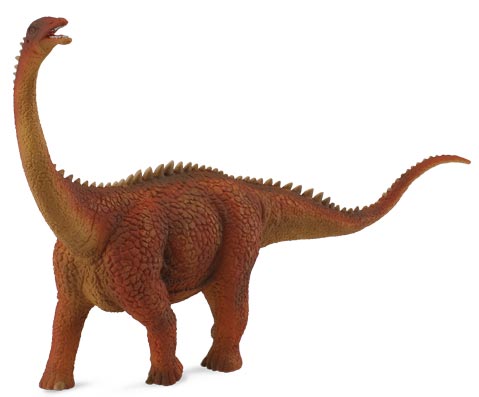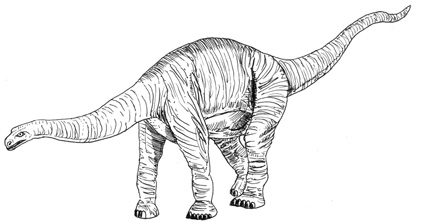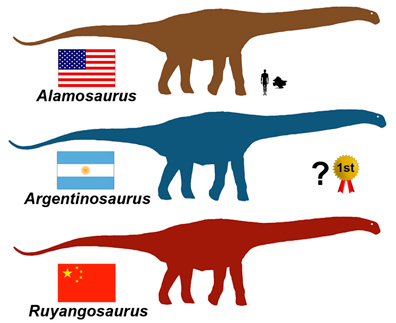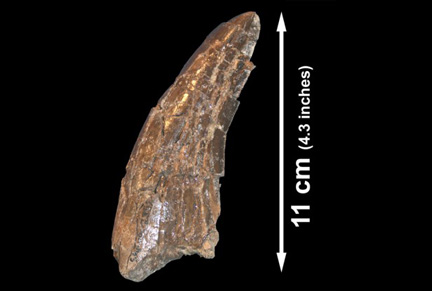Remember the Amazing Alamosaurus – North America’s Biggest Dinosaur
Alamosaurus Rivals Largest Titanosaurs after Recent Fossil Discovery
For a long time, this Late Cretaceous titanosaur called Alamosaurus sanjuanensis was the only known representative of the titanosaur group in North America. Recent discoveries have revealed that other types of long-necked dinosaur may have migrated north from South America towards the end of the Age of Reptiles. At an estimated twenty-one metres in length, scientists already knew that this particular dinosaur was a giant, but they had suggested that it was relatively lightly built and when compared to the leviathans of the titanosaur group such as Andesaurus, Antarctosaurus, Paralititan and Argentinosaurus, it remained only a “middle-weight” amongst some super-heavy-weight dinosaurs.
However, the discovery of some more fossilised bones ascribed to A. sanjuanensis may lead scientists to re-think their estimates for the size of this particular beastie, putting the Alamosaurus up there with some of the biggest land animals of all time.
New research from Montana State University’s Museum of the Rockies and the State Museum of Pennsylvania has unveiled enormous bones from North America’s biggest dinosaur. Trust the Americans to find a dinosaur potentially as big as some of the gigantic sauropods known from South America.
In a paper published in the scientific journal – “Acta Palaeontologica Polonica”, Montana State University researcher Denver W. Fowler and co-author Robert M. Sullivan from Harrisburg, Pa., describe two enormous vertebrae and a femur (thigh bone) that the team collected in New Mexico during expeditions that ran sporadically from 2003 to 2006.
Alamosaurus
The fossilised bones have been assigned to the species A. sanjuanensis a dinosaur that shared the Late Cretaceous habitat of the south-western United States with the formidable predator T. rex.
An Illustration of a Typical Giant Sauropod
Picture credit: Everything Dinosaur
Commenting on the new fossil bones, Fowler stated:
“Alamosaurus has been known for some time; its remains were first described in 1922 from the Naashoibito beds of New Mexico. Since then, more bones have been discovered in New Mexico, Utah, some really nice material from Texas, and Mexico, including a few partial skeletons.”
The size and scale of the newly discovered specimens indicates that Alamosaurus may have to be put up there with some of the dinosaur super-heavy-weights, perhaps rivalling the South American giants for the title of the largest land-living animal known to science.
Montana State University researcher Dr Holly Woodward, had shown in an earlier study that the femur thought to have come from an adult was still growing. Previous height and weight estimates based on the femur and the vertebrae are going to have to be revised and scaled upwards.
Just how big? That is the question, a spokesperson from Everything Dinosaur commented:
“Ontogeny in Dinosauria is not a precise science. Dinosaurs for example, may have been subject to indeterminant growth, that is they kept growing throughout their lives. The longer a sauropod lived the bigger it got – this makes determining maximum size for such creatures rather difficult.”
Fowler, postulated:
“Over the past 20 years, Argentinian and Brazilian palaeontologists have been unearthing bigger and bigger dinosaurs, putting the rest of the world in the shade. However, our new finds not only show that Alamosaurus is newly recognised as the biggest dinosaur from North America, but also that it was right up there with the biggest South American species: the U.S. is back in the fight for the No.1 spot.”
Although comparison of the new Alamosaurus bones with the South American species gave the researchers an idea of size, giant specimens of sauropods like Alamosaurus and Argentinosaurus are only known from very fragmentary remains offering only a tantalising glimpse of what a complete Alamosaurus might look like.
Images show Nate Carroll, left, and Liz Freedman, a doctoral student in Jack Horner’s palaeontology laboratory, posing with the complete reconstruction of the neck vertebra of an Alamosaurus. Carroll, a Montana State University student majoring in Earth Sciences, made the sculpture. Behind it is a sauropod model being attacked by a pair of dromaeosaurs in Montana States University’s Museum of the Rockies.
Fowler continued:
“We’d love to find more complete material. Fortunately, Alamosaurus bones are quite common in the Naashoibito of New Mexico, so we have a good chance of going back and finding more, but in order to dig up one of the world’s biggest dinosaurs you need one of the world’s biggest dinosaur digging teams and large digging equipment.”
The World’s Largest Dinosaur?
With the title of the “World’s Largest Dinosaur” up for grabs perhaps some new sponsors will be happy to come forward to assist the scientists with their research – the race just might be on.
Which is the Biggest Dinosaur Known to Science?
Picture credit: Montana State University/Denver Fowler
Large Titanosaur specimens are not the only fossils the scientists have found as they explore the Alamosaurus beds. For example, the team unearthed a broken Tyrannosaurus tooth, perhaps belonging to a T. rex that broke a tooth when feeding on the Alamosaurus carcase.
The Tyrannosaur Tooth found in Association with Titanosaur Material
Picture credit: Montana State University
The discovery of the broken tooth indicates that large tyrannosaurs (potentially T. rex) co-existed with large titanosaurs. They shared the same ecosystem. Some scientists have suggested that in the north of its range T. rex specialised in hunting hadrosaurs and ceratopsians whilst in the south they were mainly predators of titanosaurs such as Alamosaurus.
The Alamosaurus discovery goes beyond just “size” bragging-rights, and may have important implications for other dinosaurs. Recent discoveries by American palaeontologist Jack Horner’s and his paleo lab at the Museum of the Rockies have highlighted the importance of understanding growth and ontogeny in interpreting dinosaur evolution.
Fowler concluded by stating:
“Increasingly, we’re finding that very large or small individuals often look very different, and are often described as different species. Our findings show that Alamosaurus was originally described based on immature material, and this is a problem as characteristics that define a species are typically only fully gained at adult size. This means that we might be misinterpreting the relationships of Alamosaurus and possibly other sauropod dinosaurs too.”
A Model of an Alamosaurus (CollectA Prehistoric Life)

Picture credit: Everything Dinosaur
The picture (above) shows a CollectA Alamosaurus dinosaur model.
To view the range of CollectA not-to-scale models and figures: CollectA Age of Dinosaurs/Prehistoric Life Figures.




